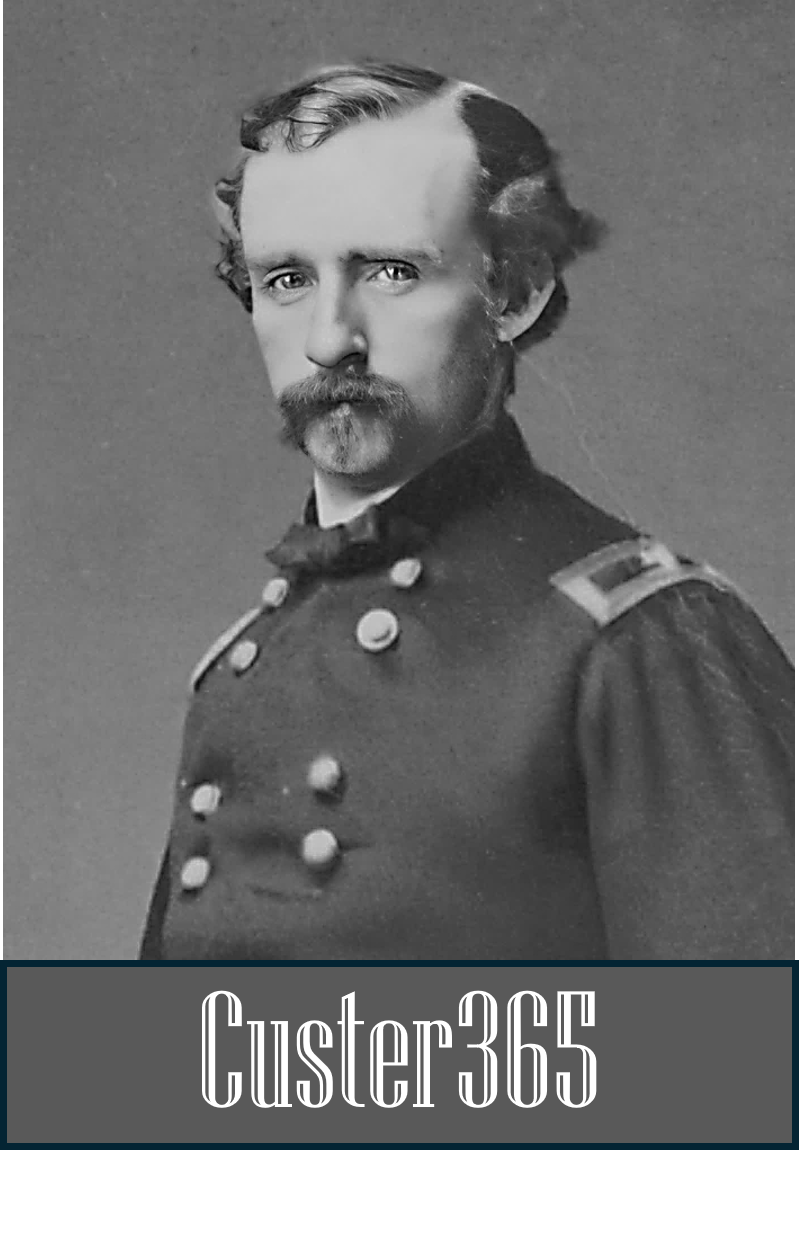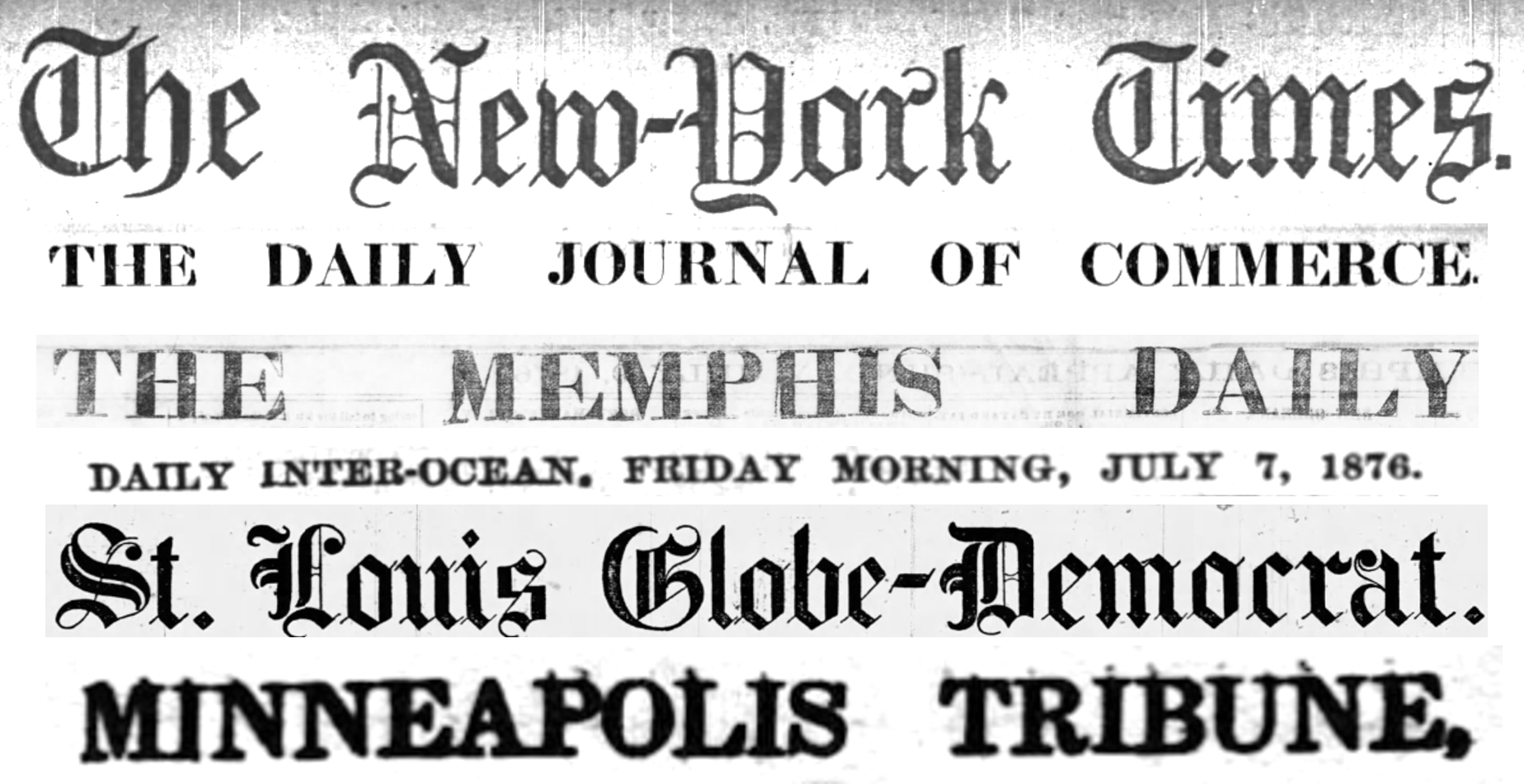JULY 9: Massacre Headlines Continue
Headlines from newspapers began trumpeting the news of the massacre of George Armstrong Custer and five companies of the 7th Cavalry at Little Big Horn on July 6, 1876.
The Bismarck Tribune, whose correspondent, Mark Kellogg, died with Custer and his troops at the battle on June 25, had initial access to information and created the first detailed account of the stunning event. According to author Chris Wimmer in his book, “The Summer of 1876,” for 22 hours on July 6 telegraph operator J.M. Carnahan transmitted 15,000 words written by Tribune publisher Clement A. Lounsberry. Newspapers across the nation picked it up and began publishing stories almost immediately.
The New York Herald, which had sponsored Tribune correspondent Mark Kellogg’s sojourn with the 7th Cavalry, sent reporters to the Centennial Exposition in Philadelphia to ask generals Sherman and Sheridan for comment.
In “The Summer of 1876,” Wimmer writes: “The generals initially dismissed the claims that Custer and part of his regiment had been wiped out. The story was simply too wild to be true. But, as they started receiving official intelligence they were forced to confirm the event. The impact of the news can’t be understated. It hit the American psyche like a sledgehammer. It was unthinkable that the country’s number one Indian fighter and a sizeable portion of his famous regiment could be destroyed.”
Initial headlines blared “CUSTER MASSACRE.” By Saturday, July 8, generals Sherman and Sheridan began talking, perhaps to control the messaging to benefit the U.S. Army. By Sunday, July 9, sub-headlines began assessing blame for the tragedy. It began falling on the shoulders of Custer.
Thursday, July 6
Bismarck Tribune, “TRIBUNE EXTRA: MASSACRED: Gen. Custer and 261 Men the Victims”
Harrisburg (PA) Telegraph, “The telegraphic dispatches of to-day inform us of a bloody engagement between the Indians and the United States troops under General Custer, in which the latter, with three hundred of his command, was killed.”
New Haven Daily Palladium, “Terrible Massacre; Fatal Attack on an Indian Camp”
The Bozeman Times, “ANOTHER BATTLE!; Gen. Custer Killed; The Seventh Cavalry Regiment Cut to Pieces!”
The Brooklyn Union, “CUSTER KILLED; Disastrous Defeat of our Soldiers by Indians; The Whole Column Annihilated.”
The Daily Independent (Helena), “INDIAN WAR; Gen. Gibbon’s Letter Relating the Terrible Massacre; A Fearful Sacrifice of Life; Custer’s Fate Definitely Settled.”
The Evening Post (Cleveland), “Death of the Most Dashing Officer of the Army”
The New York Times, “MASSACRE OF OUR TROOPS; Five Companies Killed By Indians.”
The Omaha Daily Bee, “CUSTER’S COMMAND CLEANED OUT; The Indians Almost Annihilate the U.S. Forces – Three Hundred Soldiers Killed.”
St. Louis Post-Dispatch, “INDIAN VICTORY; Desperate Fight with the Reds; Gen. Custer Makes a Dashing Charge Upon the Indians.”
San Diego Union, “EXTRA: GREAT BATTLE WITH THE INDIANS; Terrific Slaughter; Gen. Custar’s (sic) Command Annihilated; CUSTAR KILLED !”
The Buffalo Commercial, “THE CUSTER MASSACRE; The Sad News Confirmed.”
Friday, July 7
Omaha Republican Extra, THE MASSACRE; A Detailed Report of Horrible Slaughter on the Little Horn”
The Daily Critic (Washington, D.C.), “THE CUSTER MASSACRE”; Telegrams to Gen. Sheridan, General Terry’s Explanation, The News at Custer’s Home”
The New York Herald, “THE MASSACRE: The Gallant Cavalry Leader’s Death Officially Confirmed”
The Inter Ocean (Chicago), “The massacre of General Custer and five companies of the Seventh Cavalry by Sioux on the Little Big Horn River on the 25th is fully confirmed… The news which yesterday thrilled the nation by its awful vagueness and uncertainty now paralyzes the stoutest and make the bravest quail.”
Saturday, July 8
Detroit Free Press, “THE INDIAN WAR; General Terry’s Official Account of the Custer Massacre.”
The Newark Morning Register, “BY TELEGRAPH: THE CUSTER MASSACRE; Frightful Scene on the Battle Field.”
San Joaquin Valley Argus, “THE INDIAN WAR; Gen. Custer’s Regiment Annihilated.”
Sioux City (Iowa) Daily, “The Custer Massacre; Mass Meetings Held at Yankton and Salt Lake and Troops Offered the Government to Avenge Custer’s Death.”
The Council Bluffs Daily Nonpareil, “Views of Sherman and Sheridan on the Custer Massacre.”
The Journal (Evansville, Indiana), “The Custer Massacre; Opinion of Gen. Sheridan and Others Concerning the Fight.”
The (Philadelphia) Press, “CUSTER’S MARCH TO DEATH”
The St. Louis Republican, “A Conversation with General Sheridan.”
Yankton Press & Dakotan, “Sherman and Sheridan Have Something to Say About the Custer Massacre.”
Sunday, July 9
The Daily Journal of Commerce (Kansas City), “CUSTER’S CHASM; …The Remains of Their Brave Commander Alone Escaping the Scalping Knife; An Opinion That Custer Disobeyed Orders in his Zeal to Achieve Victory.”
St. Joseph Gazette, “THE RED DEVILS; A Thrilling Account of the Dashing Cavalryman’s Last Battle; A Gallant Charge – A Bloody Retreat – A Desparate Fight- And All are Dead; Official Dispatches Confirm the News – Now Let the Treacherous Sioux Meet the Fate of the Modocs; No More Quaker Policy.”
The Daily American (Nashville), “THE FRONTIER WAR; Later Particulars of the Little Horn Massacre; Superabundance of Courage the Cause of His Defeat; The Army in the West to be Rapidly Reinforced; Sheridan Considers an Appropriation of $200,000 Absolutely Necessary.”
The Daily Memphis Avalanche, “THE INDIAN WAR: Official Report of the Late Slaughter.”


